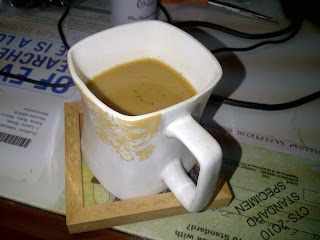A Vanilla Afternoon
We watched the NDTV 24X7 Show, Aneesha Baig's "Will Travel For Food" with great interest, specially since it featured our friend and food blogger Kalyan Karmakar and his favorite Bandra hangouts.It also covered another food blogger Shaheen Peerbhai who is famous the world over as the Purple Foodie.Shaheen spoke of her favorite finds for baking ingredients including a small place called Evellene International at Mahim,Mumbai.As it was close to where both Sue and I live,we decided to explore the place,after an afternoon by the sea with Finely Chopped, listening to his tales of Spanish travel.He went off to Fort to organize his next food walk there which he plans to hold on 16th March.
Sue had forgotten the slip of paper with the vanilla supplier's address at home so I googled and found it.We called him up and he gave us directions.When we reached,he told us he would give us a little presentation on vanilla,which made both Sue and me happy as we both love food stories.We sat in a room that smelt heavenly.
He told us that the vanilla beans he exports were bought directly from farmers in Kerala and Karnataka,which benefits the farmers as well.That was an eye-opener cos I always thought the beans were imported and therefore expensive.Actually it is the process which is labour-intensive that adds to the cost.Earlier vanilla flowers were pollinated by the efforts of hummingbirds and bees.Now each of them is pollinated individually to produce it in larger quantities.The flower has to be pollinated within a day.One flower produces only one fruit only.
Vanilla beans (or the fruit) are of Grade A,B or C with A being the most expensive.Grade A beans are oily and moist and the longest.Grade B are shorter.Grade C are the broken pieces but are flavorful,all the same.
Vanilla is the only edible fruit from the Orchid species. It grows as vines entwining around host trees.It takes three years for a vine to be mature and produce flowers and 9 months for a vanilla bean to be on the vine to be able to produce the aroma after it is cured(stored till it turns dry).This requires warm weather which is why vanilla comes from Madagascar,South America,Mexico and India.
Storage of vanilla beans is done in vacuum packs to prevent moulds.This has to be aired for a short while every ten days or so.The white coat you see in the bean above is actually vanilla that has extruded and is a sign of superior quality not moulding.
In the past we have been using vanilla essence made of synthetic vanilla.Using it in the natural form as beans by splitting them and scraping the seeds,is easy! One can also use the outer bean for flavor.
Vanilla is also sold as pure vanilla extract and one needs just a drop of it at a time.
We then saw Vanilla Powder (which Sue is holding above).This is ground with sugar and made into Vanilla Sugar.We had coffee with it and it was divine!
Vanilla can be added to yoghurt,salads or pancakes.Sue mentioned having vanilla in savory dishes.A study done in some patients at the St George Hospital near London showed that vanilla lead to satiety and weight loss.Sue is due to return to UK soon where vanilla is extremely expensive









Comments